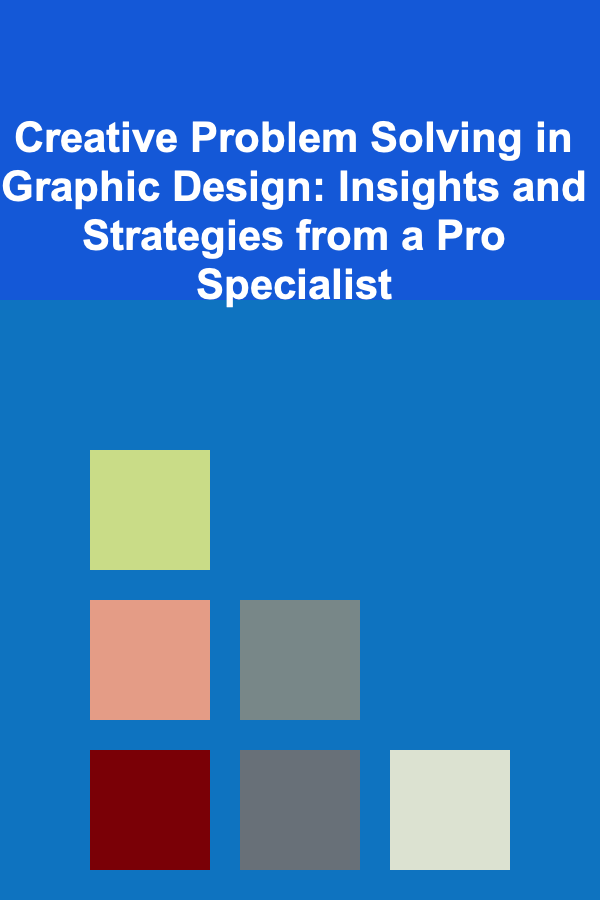
Creative Problem Solving in Graphic Design: Insights and Strategies from a Pro Specialist
ebook include PDF & Audio bundle (Micro Guide)
$12.99$5.99
Limited Time Offer! Order within the next:

Graphic design is not just about making things look visually appealing. At its core, graphic design is a form of problem-solving. Every design project starts with a challenge---whether it's creating a logo that encapsulates a brand's essence, designing a website that's intuitive and engaging, or crafting an advertisement that attracts attention and drives action. The ability to approach these challenges creatively and solve them effectively is what separates good designers from great ones.
In this article, we will explore how professional graphic designers approach creative problem-solving, dive deep into strategies that can be applied to various design challenges, and provide actionable tips that you can use to enhance your own problem-solving abilities.
Understanding the Problem: The First Step in Problem-Solving
Before you can start creating, you must first understand the problem you are solving. This is the foundation of any creative solution. The clearer you are on the problem, the more effective your design solution will be.
1.1 Analyzing the Design Brief
The first and most important step is to understand the design brief. A design brief is the roadmap for your project and often comes directly from the client, or your internal team, outlining the project's objectives, target audience, and design constraints. A well-defined brief includes:
- Objective: What is the goal of the design? Are you creating a logo, website, or print material?
- Target Audience: Who will interact with this design? Understanding your audience's needs and preferences is crucial.
- Message: What message should the design convey? Is there a tone, emotion, or call to action that needs to be communicated?
- Brand Guidelines: Is there a specific visual style the design must adhere to? This could include logos, color palettes, and typography.
Understanding these elements allows you to align your design with the client's vision while staying within project constraints.
1.2 Gathering Information and Conducting Research
Beyond the brief, gathering more information about the brand, competitors, industry trends, and even cultural influences can provide valuable insights. Here are some key research areas to explore:
- Brand Identity: Explore the brand's existing materials---logos, packaging, marketing collateral---to understand its visual language and values.
- Competitor Analysis: Look at how competitors approach their design. This can inform your design choices and help you identify ways to stand out.
- Audience Analysis: Research the target audience's preferences and behavior. What type of designs resonate with them? Are they more traditional or do they lean towards innovative, cutting-edge designs?
By immersing yourself in research, you will gain a broader understanding of the problem, which will inform your creative process.
Generating Ideas: Creative Exploration and Ideation
Once you have a clear understanding of the problem, it's time to brainstorm creative ideas. This stage is about thinking outside the box, pushing boundaries, and exploring different possibilities.
2.1 Divergent Thinking
Divergent thinking is the process of generating multiple ideas or solutions. The goal here is not to focus on finding the "right" answer immediately, but to explore as many ideas as possible without judgment. This phase encourages free-flowing creativity.
Here are some techniques to help stimulate divergent thinking:
- Mind Mapping: Start with the central idea and branch out into different themes or concepts. This helps you explore various angles and connections.
- Sketching: Use paper and pen to sketch out as many rough ideas as possible. The act of physically sketching allows your mind to flow freely without restrictions.
- Word Association: Write down random words related to the project and explore how they might fit into your design. For example, if you are designing a logo for an eco-friendly brand, words like "green," "nature," and "sustainability" can spark new ideas.
The key during this phase is to let go of perfection and embrace all ideas, even if some of them seem wild or impractical at first.
2.2 Convergent Thinking
After generating a wide range of ideas, the next step is convergent thinking---the process of narrowing down and evaluating which ideas are worth pursuing. This stage involves critically assessing your ideas and selecting the most promising ones that align with the design objectives.
Key questions to consider during this phase:
- Does the idea meet the brief? Does it address the project's goals and objectives effectively?
- Is it feasible? Can you execute this idea given the resources, time, and tools at your disposal?
- Is it unique? Does the design stand out from the competition? Is it fresh and innovative?
This phase may involve creating rough mock-ups or prototypes to see how your ideas work in the real world. Testing out these ideas through wireframes, initial designs, or mood boards will help you make informed decisions about the direction of your design.
Refining the Concept: From Rough Ideas to Professional Solutions
Once you've narrowed down your ideas, it's time to refine them into a professional and polished design. This phase involves focusing on the details and making sure the design aligns with the original objectives and audience needs.
3.1 Iterative Design Process
One of the most important strategies in creative problem-solving is the iterative design process. Iteration involves repeating a process, making small improvements each time. In design, this means continuously refining your ideas based on feedback, testing, and your own judgment.
Here's how to effectively implement iteration:
- Prototype and Test: Create prototypes or mock-ups to test how the design will work in its final context. This can be especially important in web and app design, where usability is key.
- Gather Feedback: Seek feedback from colleagues, clients, or users. This input can reveal blind spots or areas where the design can be improved.
- Refine and Evolve: Based on feedback, refine the design. Don't be afraid to make significant changes if necessary. Great designs often come from multiple rounds of iteration.
3.2 Attention to Detail
In the refining phase, small details make a significant difference. Focusing on the finer aspects of design---such as typography, color harmony, spacing, and alignment---will elevate your work from good to great.
For example:
- Typography: Choose fonts that enhance readability and convey the appropriate tone. The way text is arranged can completely change the perception of your design.
- Color Theory: Select a color palette that aligns with the brand's identity and evokes the right emotions. Understand the psychological impact of colors on the viewer.
- Composition: Pay attention to the layout and structure. Proper use of white space and alignment ensures the design is clean, balanced, and easy to navigate.
Problem-Solving in Real-World Scenarios
Creative problem-solving isn't just limited to abstract challenges. In real-world scenarios, designers often face tight deadlines, budget constraints, and unexpected obstacles. Here are some strategies for overcoming common challenges:
4.1 Managing Client Expectations
One of the biggest challenges in graphic design is managing client expectations. Clients may not always be able to articulate their needs clearly, or they might have unrealistic expectations. It's important to set clear boundaries and communicate effectively throughout the design process.
- Clarify Expectations Early: Make sure you understand the client's vision from the start. Ask clarifying questions to avoid misunderstandings.
- Provide Regular Updates: Keep the client in the loop with progress updates and mock-ups, so there are no surprises at the end.
- Be Open to Feedback, but Set Limits: Clients may request numerous changes, but it's important to maintain creative control. Politely push back when changes stray too far from the original vision.
4.2 Working Under Tight Deadlines
Time constraints can put additional pressure on a designer's creativity. However, the key to effective problem-solving under tight deadlines is to stay organized and prioritize tasks.
- Break Down the Project: Divide the project into smaller tasks and set deadlines for each. This will help you stay focused and make the process more manageable.
- Focus on What Matters: When under time pressure, focus on the most important aspects of the design that will have the biggest impact. Don't get bogged down by minor details that can be fine-tuned later.
4.3 Overcoming Creative Blocks
Even the most experienced designers encounter creative blocks from time to time. When you hit a wall, try these strategies to get your creativity flowing:
- Take a Break: Step away from your work for a little while. Sometimes a fresh perspective is all you need to solve a problem.
- Seek Inspiration: Look at other design work, nature, or even completely unrelated fields to spark new ideas.
- Collaborate: Sometimes, bouncing ideas off of others can help break through a creative block and offer new insights.
Conclusion: Developing Your Problem-Solving Mindset
Creative problem-solving in graphic design is about more than just technical skills---it's about cultivating a mindset that embraces challenges and finds innovative solutions. By following the process of understanding the problem, brainstorming multiple ideas, refining your concepts, and working through real-world constraints, you can develop as a designer who is capable of tackling any design problem that comes your way.
Remember, the key to being a great problem solver is to stay curious, flexible, and open-minded. Each project is an opportunity to expand your creative toolkit and refine your problem-solving skills. By practicing these strategies, you will not only create effective and beautiful designs but also become a more confident and capable designer.

How to Curate a Recipe Collection for Special Occasions
Read More
How to Keep Your Home's Air Ducts Clean and Maintained
Read More
How to Make the Most of Closet Doors for Extra Storage
Read More
How to Plan a DIY Family Movie Set at Home
Read More
How to Update Your Address on All Important Accounts
Read More
How to Use Visual Aids for Family Scheduling
Read MoreOther Products

How to Curate a Recipe Collection for Special Occasions
Read More
How to Keep Your Home's Air Ducts Clean and Maintained
Read More
How to Make the Most of Closet Doors for Extra Storage
Read More
How to Plan a DIY Family Movie Set at Home
Read More
How to Update Your Address on All Important Accounts
Read More